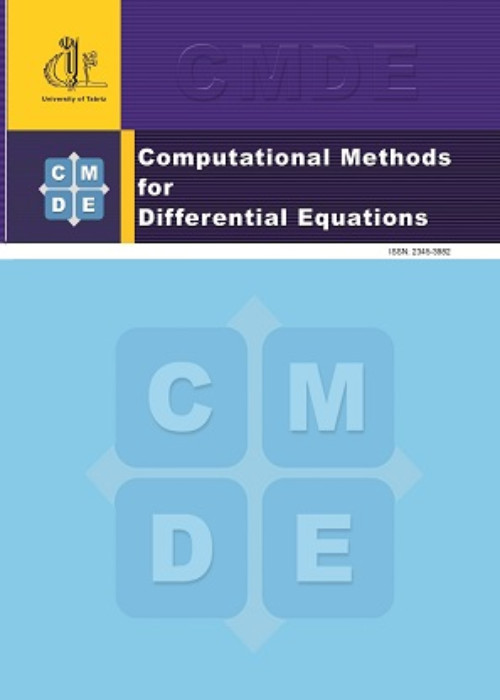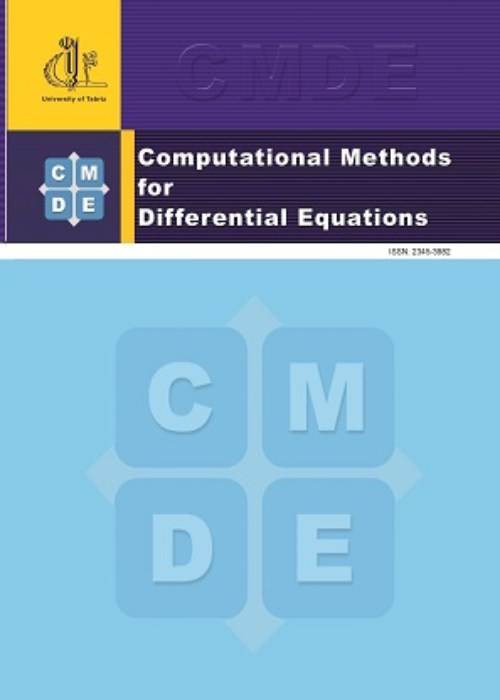فهرست مطالب

Computational Methods for Differential Equations
Volume:12 Issue: 1, Winter 2024
- تاریخ انتشار: 1402/12/26
- تعداد عناوین: 15
-
-
Pages 1-15In this paper, for solving the HIV fuzzy mathematical model, it is first transformed into a system of three nonlinear fuzzy Atangana-Baleanu-Caputo (ABC) fractional differential equations with three unknowns and fuzzy initial values. Then, using the generalized Hukuhara difference and ABC fractional derivative and applying the fuzzy numerical ABC-PI method, its fuzzy solution is calculated. Moreover, some theorems are defined to prove the existence and uniqueness of the solution. Then, it is explained that the proposed method can In this paper, for solving the HIV fuzzy mathematical model, it is first transformed into a system of three nonlinear fuzzy Atangana-Baleanu-Caputo (ABC) fractional differential equations with three unknowns and fuzzy initial values. Then, using the generalized Hukuhara difference and ABC fractional derivative and applying the fuzzy numerical ABC-PI method, its fuzzy solution is calculated. Moreover, some theorems are defined to prove the existence and uniqueness of the solution. Then, it is explained that the proposed method can be used for the system of any equations with unknowns. Therefore, in order to determine the solution of the fuzzy mathematical model of the transmission of COVID-19, it is transformed into a system of six nonlinear fuzzy Atangana-Baleanu-Caputo (ABC) fractional differential equations with six unknowns and fuzzy initial values and is solved similarly. At the end, a numerical example is presented to verify the effectiveness of the proposed method.be used for the system of any equations with unknowns. Therefore, in order to determine the solution of the fuzzy mathematical model of the transmission of COVID-19, it is transformed into a system of six nonlinear fuzzy Atangana-Baleanu-Caputo (ABC) fractional differential equations with six unknowns and fuzzy initial values and is solved similarly. At the end, a numerical example is presented to verify the effectiveness of the proposed method.Keywords: Fuzzy Atangana-Baleanu-Caputo(ABC) fractional derivative, Fuzzy ABC fractional differential equations, HIV fuzzy mathematical model
-
Pages 16-30In this paper, we propose a kernel-based method for some pricing financial options. Based on the ideas of the kernel-based approximation and finite-difference discretization, we present an efficient numerical method for solving the generalized Black-Scholes option pricing models. Utilizing the reproducing property of kernels, we introduce an efficient framework for obtaining cardinal functions. Also, we discuss the solvability of final system to obtain some remarkable results. We provide the error estimate of the proposed kernel-based method and verify its efficiency and accuracy by numerical experiments.Keywords: Black-Scholes equation, European option pricing, Kernel-Based Method, Finite difference discretization, Error analysis
-
Pages 31-43In this paper, we introduce three types of generalized special functions: beta, Gauss hypergeometric, and confluent hypergeometric, all involving two generalized M-series at their kernels. We then give several properties of these functions, such as integral representations, functional relations, summation relations, derivative formulas, transformation formulas, and double Laplace transforms. Furthermore, we obtain solutions of fractional partial differential equations involving these new generalized special functions and then we present graphs of the approximate behavior of the solutions. Also, we introduce a new generalized beta distribution and incomplete beta function. Finally, we establish relationships between the new generalized special functions and other generalized special functions found in the literature.Keywords: Double Laplace transform, fractional partial differential equations, beta function, Gauss hypergeometric function, confluent hypergeometric function
-
Pages 44-55This article studies a complex hyperbolic Schrodinger dynamical equation that is associated with nonlinear media via ultra short pulse propagation. The modified simplest equation method is executed to construct complex solitary wave and other solutions of the aforesaid equation by considering it in conformable M-fractional derivative sense. The acquired solutions are in the form of solitary and periodic waves and rational functions. These solutions are also described with their graphical representations by assuming appropriate values of required parameters. Moreover, the results show that the aforesaid approach can be effective for solving such nonlinear Schrodinger equations arising in nonlinear optics and physical sciences.Keywords: The modified simplest equation method, Exact solutions, Truncated M-fractional derivative
-
Pages 56-66This paper is associated with a nonlinear parabolic moving boundary problem raised from the mathematical modeling of the behavior of the breast avascular cancer tumors at their first stage. This model is a modification of the previous works. Using the weak form of the proposed problem, the uniqueness of the solution is proved. Based on the finite difference method, a variable time step approach is proposed to solve the problem, numerically. It is shown that the numerical approach preserves the positivity of the solution and is unconditionally stable. To show the robustness and ability of the numerical method, the numerical and exact solutions are discussed and compared for two examples with the exact solutions.Keywords: Moving boundary, breast cancer, uniqueness, variable time step
-
Pages 67-76This paper deals with a class of stochastic delay differential equations (SDDEs) of second order with multiple delays. Here, two main and novel results are proved on stochastic asymptotic stability and stochastic boundedness of solutions of the considered SDDEs. In the proofs of results, the Lyapunov-Krasovskii functional (LKF) method is used as the main tool. A comparison between our results and those are available in the literature shows that the main results of this paper have new contributions to the related ones in the current literature. Two numerical examples are given to show the applications of the given results.Keywords: SDDEs, Second order, multiple constant delays, Stability, boundedness, Ito formula, LKF
-
Pages 77-88In this paper, we introduce an operational vector approach that uses Chebyshev wavelets and hybrid functions to approximate the solution of the Riccati differential equation arising in nonlinear physics equations celebrated as cosmology problems. The scheme's main features include a simple structure based on certain matrices and vectors, low computational complexity, and high accuracy. The method is direct, which means that projection methods are not used throughout the approximation procedure in order to reduce computational cost. Error analyses are provided, and several numerical examples and comparisons confirm the proposed scheme's superiority.Keywords: Riccati equation, Direct method, Chebyshev wavelets, Hybrid functions, Operational vectors
-
Pages 89-99In this study, we give results on the existence and uniqueness of solutions for generalized fractional integrodifferential equations with a nonlocal terminal condition. We have proved the existence of solutions to the problem proposed using the Schauder fixed point theorem and the uniqueness of its solutions is proved using the Banach fixed point theorem. At the end, we discussed the examples to support our results.Keywords: Generalized fractional derivative, fractional integrodifferential equation, terminal condition, Schauder fixed point theorem
-
Pages 100-116In this paper, the existence, uniqueness, compactness, and stability of a coupled random differential equations involving the Hilfer fractional derivatives with nonlocal boundary conditions are discussed. Arguments are discussed via some random fixed point theorems in a separable vector Banach spaces and Ulam type stability. Some examples are presented to ensure the abstract results.Keywords: Coupled fractional differential systems, Random variable, Hilfer fractional derivatives, Nonlocal conditions, fixed point theorem, Ulam-Hyers stability
-
Pages 117-135In the current study, a one-step numerical algorithm is presented to solve strongly non-linear full fractional duffing equations. A new fractional-order operational matrix of integration via quasi-hat functions (QHFs) is introduced. Utilizing the operational matrices of QHFs, the main problem will be transformed into a number of univariate polynomial equations. Absolute errors of the results in approximations and convergence analysis are addressed. Ultimately, five examples are provided to illustrate the capabilities of this algorithm. The numerical results are illustrated in some Tables and Figures, for different values of the parameters $\alpha~ and~ \beta$.Keywords: Fractional Duffing differential equations, Numerical algorithms, Strongly nonlinear, Quasi-hat function, Fractional operational matrix
-
Pages 136-148This study examines the balanced Maruyama with two step approximations of stochastic Hopfield neural networks with delay. The main aim of this paper is to discover the conditions under which the exact solutions remain stable for the balanced Maruyama with two-step approximations of stochastic delay Hopfield neural networks (SDHNN). The semi martingale theorem for convergence is used to demonstrate the almost sure exponential stability of balanced Maruyama with two-step approximations of stochastic delay Hopfield networks. Additionally, the numerical balanced Euler approximation's stability conditions are compared. Our theoretical findings are illustrated with numerical experiments.Keywords: Almost sure exponential stability, balanced two step Maruyama numerical approximations, Hopfield neural networks, Stochastic delay differential equations
-
Pages 149-158The main purpose of this paper is to introduce a new method to analyze the effects of the white and colored noise perturbations on the robotic arms. To show the efficiency of the presented idea the simplest manipulator, two link robotic arm, is considered. Most previous noise analyses of manipulators are done using mechanical or electrical modeling. Applying exact kinematic equations of the robots is the novelty of the proposed research. For this purpose, by adding white and colored noise terms in each angle function of the robotic arm, the end effector linear velocity is studied. Also, mechanical variation's effect on the final velocity in noisy space is considered. The longer the length of the links, the more the noise effect. Analysis of simulation results shows that the root mean square error in 2nd order is more than when angle functions are of the first order. Also, the mean square error is less when colored noise is added in comparison to the white noise. The Matlab programming is used to perform numerical examples to show the efficiency and accuracy of the presented idea.Keywords: Colored noise, Jacobian, Stochastic differential equation, Two link robot, Velocity kinematics, White noise
-
Pages 159-172In this article, the Srivastava-Luo-Raina $M$-transform is applied to establish the image formula for the multiplication of a family of polynomials and the incomplete $I$-functions. Additionally, we discovered the image formulations for a few significant and valuable cases of incomplete $I$-functions. The conclusions drawn in this study are general in nature, and by assigning specific values to the parameters involved in the primary conclusions, numerous previously discovered and few undiscovered conclusions can be achieved.Keywords: Incomplete gamma function, Incomplete $I$-functions, Mellin-Barnes type contour integral
-
Pages 173-188Based on the time-fractional Black-Scholes pricing model, the evaluation of an American-style option problem can be formulated as a free boundary problem. It is equivalent to a time-fractional parabolic variational inequality. Due to the time-fractional derivative involved in the problem, increasing the computational cost for large final times has been expected in the numerical solution for this problem. In this paper, we want to propose a new adaptive numerical method to solve this problem accurately, with low computational cost. The presented method is based on interpolating wavelets family. An adaptive scheme in time discretization with an adaptive wavelet collocation method for space discretization has been used for the given problem. We show that combination of interpolating wavelet basis and finite difference method, makes an accurate structure to design an optimal adaptive mesh for this problem. The presented computational mesh by this method can prevent growing of computational cost by time. The performance of the proposed method has been tested by means of some numerical experiments. We show that, in comparison with the full grid algorithms, the presented adaptive algorithm can capture the priori unknown free boundary and is able to find the value of American put option price with high accuracy and reasonable CPU time.Keywords: Black-Scholes inequality, American option price, Obstacle problem, Parabolic variational inequality, Caputo, Riemann–Liouville fractional derivative, Interpolating wavelets, Adaptive mesh refinement, Semi-smooth Newton method
-
Pages 189-195In this paper, for solving linear and nonlinear Volterra integral equations of the first kind with discontinuous kernels, the Adomian decomposition method, and the modified Adomian decomposition method are presented. We convert the main equation into the Volterra integral equation of the second kind. The numerical examples are given to denote the accuracy of the suggested method.Keywords: Volterra integral equation, Piecewise continuous kernel, Modified Adomian decomposition method


